Menus
- Built on sound
- Smooth and jerk-free from 3,000 rpm
- Video of the driving report
- Basically tight coordination
- With Bosch curve ABS
- Ducati Scrambler 1100 Special for 14,290 euros
- MOTORCYCLE conclusion
- The engine of the Ducati Scrambler 1100
- The competition
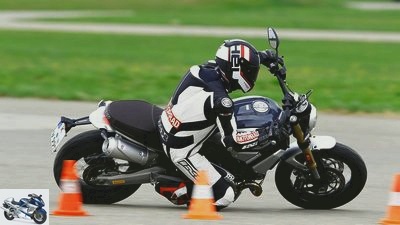
factstudio.de
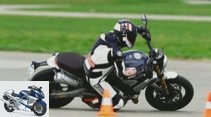
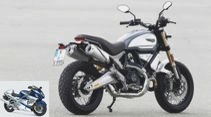
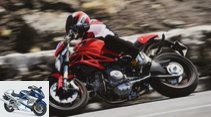
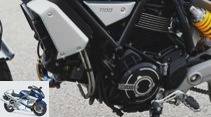
19th photos
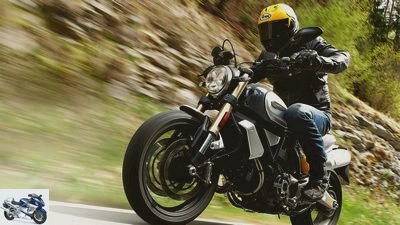
factstudio.de
1/19
Top test of the Ducati Scrambler 1100 Special.
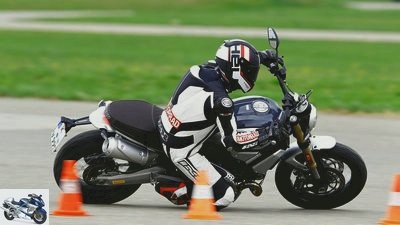
factstudio.de
2/19
Per hang-off looking for tenths, the Scrambler 1100 simply touches down a little too early.
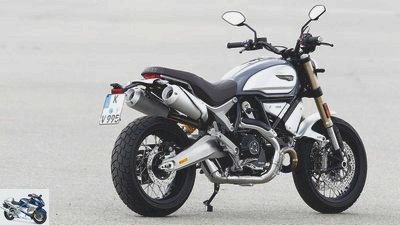
factstudio.de
3/19
Colour? Ducati has christened it “Custom Gray”. Only the fork and seat break the gray and black monotony.
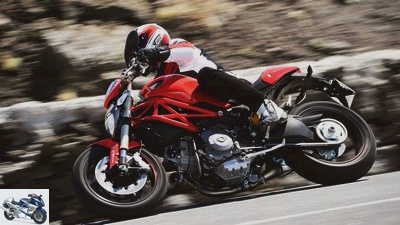
factstudio.de
4/19
The air-cooled 1100 L-Twin was used for the last time in the Monster 1100 Evo…
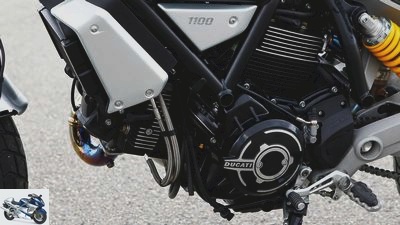
factstudio.de
5/19
…before he makes his modernized comeback in the current Scrambler as a black fellow with silver ribs.
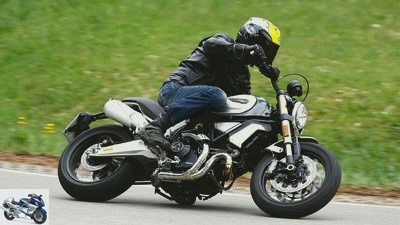
factstudio.de
6/19
A motorcycle with a V-twin swings around the corner, as the shiny bends show.
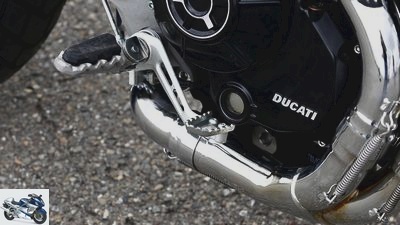
factstudio.de
7/19
The Scrambler should also be able to offroad a bit. Jagged notches and levers provide support …
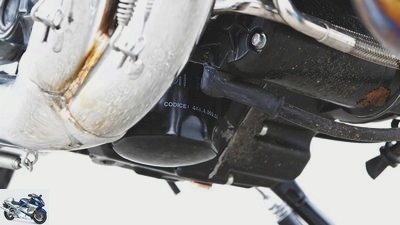
factstudio.de
8/19
… while the easily accessible oil filter warns you to be careful. Protection is missing.
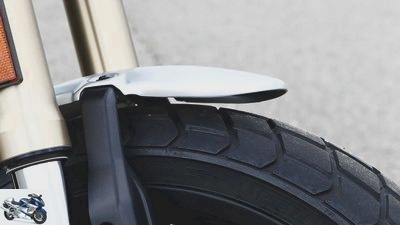
factstudio.de
9/19
Once again off-road: there is still space for the mudguard, because a coarser profile fits underneath.
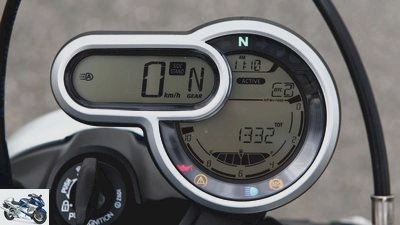
factstudio.de
10/19
Round digital instrument with extra display for speed and gear selection.
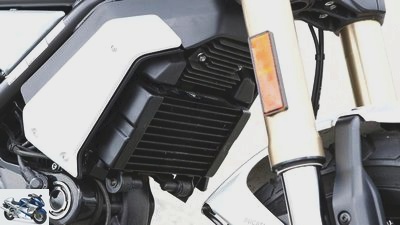
factstudio.de
11/19
Ribs among themselves. Lima regulator and small oil cooler are discreetly hidden under the steering head.
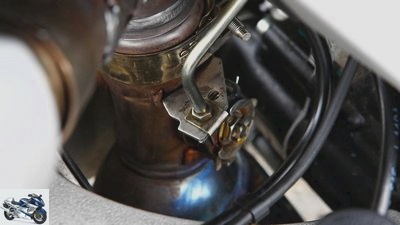
factstudio.de
12/19
First the exhaust gases scurry through the big cat, then they have to pass the flap.
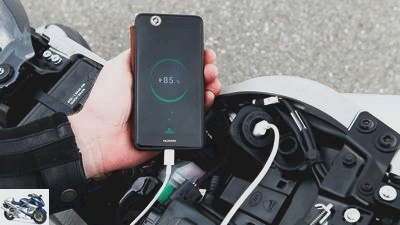
factstudio.de
13/19
Charge master: The USB port provides power for smartphones and the like.
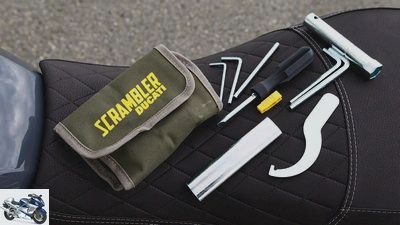
factstudio.de
14/19
Attractive tool bag that contains the most important utensils.
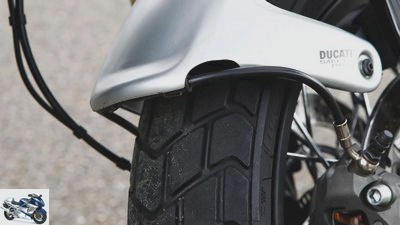
factstudio.de
15/19
Hidden: Ducati has elegantly integrated the brake line that leads from one saddle to the other in a bead on the rear edge of the mudguard. A real gem for the eye. She should only get more dirt than usual.
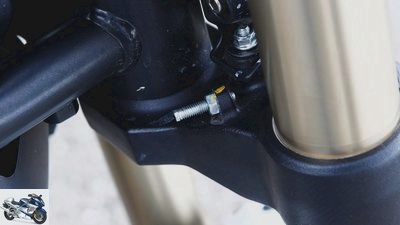
factstudio.de
16/19
At the stop: It is questionable whether the steering stop will last forever. The thread mount on the fork bridge has to absorb a lot of force in the worst-case scenario and tears off quickly. Let’s not say anything about the appearance. That could be constructed more valuable.
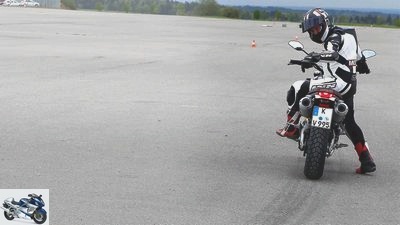
factstudio.de
17/19
It is clear who is going to get the Karcher. The top tester simply paints black lines on the asphalt.
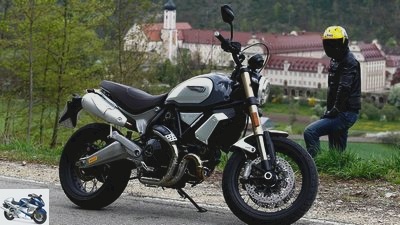
factstudio.de
18/19
Even if the name suggests otherwise, the Scrambler is not the bike for the rough. She relies on emotions. Your L-Twin is an attraction built on great sound.
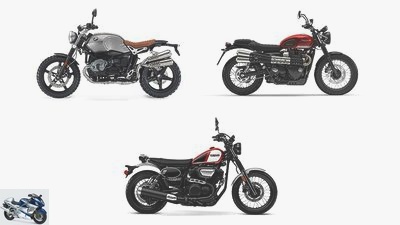
factstudio.de
19/19
BMW R nineT Scrambler (l.o.), Triumph Street Scrambler (r.o.) and Yamaha SCR 950 (below).
Ducati Scrambler 1100 Special in the top test
Built on sound
Ducati brings back the large, air-cooled L-Twin for the new Scrambler 1100. Our extensive top test shows what it can do and why its sound reflects the character of the entire motorcycle.
Fourth gear. The traffic light many car lengths away changes the light signals. Green is followed by red, followed by yellow. The prompt is to stop. Not unusual so far. In the tight, 815 millimeter high saddle of the new tested here D.ucati Scrambler 1100 Special (basic version Scrambler 1100), because this scene marks the beginning of a wonderful audio sample of the air-cooled 90-degree V-Twin. Since the light signal is still a long way off and the traffic is negligible, downward gear changes take over the deceleration work. At level four – which drives the Scrambler 1100 in the city smoothly and without chain whips – level three follows. You can definitely imagine the next steps. What is new, however: What kind of sound is that? Snotty babbling sounds the Duc with each gear change down from its two pots in the rear. But not in the pubescent, annoying way that annoys and makes too many friends of the raised index finger appear on the scene. No, the Scrambler spices up the apparently chaotic exhaust slapping with a well-bred note. Quasi a model student with a mohawk on his head and a ring in his nose. But what is even more important in all of this: the driver is the primary recipient of this well-measured sound experience. Although audio samples of the Scrambler 1100 also reach the environment, they hit the pilot most clearly, he is in the center of the concert.
Buy complete article
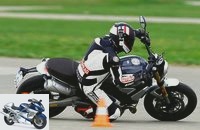
Ducati Scrambler 1100 Special in the top test
Built on sound
Soundcheck Ducati Scrambler 1100 Special
And he can’t get enough of it. This engine is alive, erecting a man-sized memorial for the two-cylinder in V-configuration in the first few minutes of contact, only blown around by a cooling airstream and protected from heat collapse by an oil cooler. The 1100 Luftikus disappeared from the Ducati range some time ago, and was last used in the Monster 1100 Evo. It came in 2010 and disappeared again in 2013. Now he’s celebrating his comeback. Shows with a powerful sound that he is standing with both feet, err, wheels, firmly on the ground, has come to stay. Before misunderstandings arise: The Ducati Scrambler 1100 Special sends its combustion noises clearly audible to the outside, without exceeding the limit of intrusiveness. It produces the best of all symphonies for V2 fans without being noisy. Ducati claims that the Scrambler 1100 is the first model that has invested a lot of time in “sound engineering”. We like to believe without further proof.
Smooth and jerk-free from 3,000 rpm
Meanwhile, the Ducati Scrambler 1100 Special is at the traffic light, the engine is bubbling sonorous, reserved and evenly. Almost like a well behaved cruiser drive. The comparison is only correct at the moment of standstill. As soon as green releases the road again, the Duc-V2 reveals differences. In terms of sound and behavior. Willingly and without harm, the 90-degree twin steps out from below. The clutch can be dosed cleanly when the engine is warm, and when the unit is cold, and with it oil, it tears easily. The gears find each other quickly via the too short gear lever, only sometimes an intermediate gear gets lost in the transmission. From 3,000 revs, it goes smoothly and without jerks, with light, never annoying vibrations in every gear. The whole thing is accompanied by a sound that immediately makes it clear: Here I am. Challenge me Use my strength.
Why not? Let’s go. The Ducati Scrambler 1100 Special doesn’t promise too much at first. After the strong step out below, she marches on with strong pressure. In addition, the two pots with a chamber system trumpet pure joie de vivre from their outlets. Controlled by a flap, you will always find the right onomatopoeic background for the current driving maneuver. So it goes lively towards mid-speed, the storm is on the performance peak. Ducati promises 86 horsepower for the eleven-to-one engine. They are at 7,500 revolutions. On the test bench there was even a little more, the Duc pressed 86.7 HP at 7,800 rpm onto the roller. However, full power is only available in the Active and Journey riding modes. In city mode, it remains below that with a measured 80.5 hp. Otherwise, the configuration differs in response behavior, which is most spontaneous in active mode and most gentle in city mode. The setting of the traction control also changes to match this set-up. As usual with Ducati, the trainer can also intervene in the individual modes, change the response behavior and TC according to his taste. Otherwise it remains to be stated: The traction control works inconspicuously safely, the motor reacts very predictably to accelerating even in active mode, which is why we are now continuing with the climb to the performance peak of the scrambler.
Video of the driving report
The sound gains in importance again. If the Ducati Scrambler 1100 Special pushes the horse and rider forward with a beefy and powerful force until just behind mid-rev, it only loses the desire to savor the entire rev range a little later. This can be clearly seen in the performance curve. Up to 6,500 rpm it constantly generates more and more power towards the rear wheel. But from this moment on the curve flattens noticeably – even if only slightly at first. The turning to peak performance then feels tough, the crisp verve with which the Scrambler mastered everything before is missing. And you can hear that too. The engine loses its powerful temper. From the full beat of the two cylinders, a strenuous drumming develops. The breath is simply out, the high-frequency pulse has robbed the engine and sound of their sovereignty.
Basically tight coordination
However, the fun of squeezing the Ducati Scrambler 1100 Special has another little hole, because whenever the engine is supposed to cheer up, the pace changes from casual to sporty, the chassis does not play along ideally. The fully adjustable fork and the damper, which can be adjusted in preload and rebound, have a fundamentally tight set-up, but their response should be smoother. In the basic setting recommended by Ducati (compression and rebound two revolutions each), the fork always chugs slightly, uses every impulse as a stimulus and passes it on directly to the driver. There is constant movement in the handlebars. The front works a bit more smoothly with the settings from the top test. Her bumpy manner, which is particularly noticeable when traveling at constant speed, cannot be turned off completely.
The subject of responsiveness is not alien to the directly hinged damper. It guides the rear wheel more gently over slight distortions, but passes larger breaks on to the rider without being filtered. During the sporty ride, the very progressive tuning of the fork also hampers clean front wheel guidance on rumble surfaces. The coordination is still good on flat, curved asphalt with corresponding load changes. If it gets bumpy, however, there is some unrest. The only thing that helps is to guide the handlebars with delicate hands.
With Bosch curve ABS
Or slow down. That also goes much better with the relaxed seating position. The pilot sits upright on the Ducati Scrambler 1100 Special, and is stretched out like a small sail in the wind thanks to the handlebars that are more than 80 centimeters wide. The 15 liter tank of the scrambler, which weighs 211 kilograms when fully fueled, turns out to be a small problem area. The shapely specimen lacks bulges for the knees that would like to move closer together.
Otherwise the arrangement fits. Such a high and, above all, wide handlebar has something for itself. Although the feedback from the front wheel decreases, the Scrambler quickly follows the driver’s request for the next hook thanks to the large lever travel. With a wheelbase of 1,514 millimeters and a caster of 111 millimeters, it is more concerned with stability, the butted rod helps it to be reasonably maneuverable at country road speed and effectively supports effortless cornering. You can always rely on the brakes. The radial pliers grip easily, the Bosch curve ABS also takes the scare off emergency stops in an inclined position. No pleasure, however: motorway stages. The straight sitting posture proves to be a spoilsport even at the recommended speed. The scrambler pilot has to fight the wind with a lot of power from his back. No pleasure.
Ducati Scrambler 1100 Special for 14,290 euros
But blame the scramblers for that? By the standards of the 1000 point rating, she has to live with deductions. It also doesn’t set a highlight when it comes to the price-performance ratio. At 14,290 euros, the Ducati Scrambler 1100 Special does not pass as a bargain, its sister model with cast wheels is available from dealers from 12,990 euros. Price and costs – 4.9 liters of consumption per 100 kilometers are still okay – are not what trigger the want-to-have reflex.
The Ducati Scrambler 1100 is remembered for completely different aspects. It decelerates because it immediately shows the red card to every request for athletic strength, emphasizing its suitability as a lusty, lively mobile home for fun and fun. At the same time, it speeds up the pulse with its full sound, arouses pure emotion in the hearts of V-Twin fans. Her world is not called performance, her world stands for sympathetic experience, perception, a feast for the ear.
MOTORCYCLE conclusion
If you expect off-road talent, a lot of dynamism or perfect everyday use, the Ducati Scrambler 1100 Special will disappoint. Even if her name suggests something else, especially in relation to the rough. Their premise is not useful. Your world is based on what makes motorcycling the most beautiful experience on two wheels: emotions. Your L-Twin is an attraction built on great sound.
The engine of the Ducati Scrambler 1100
Of course, Ducati already had an air-cooled L-Twin with almost 1,100 cubic centimeters before the current Scrambler. Most recently, this heart beat with the bore-to-stroke ratio of 98 x 71.5 mm in the Ducati Monster 1100 Evo, which was first presented in autumn 2010. There it was still good for 95 racy horses at 7,500 rpm, while in the Scrambler it has to be satisfied with a good ten ponies less. Interesting difference between the two models: The 1100 Evo got by with one spark plug per cylinder, with the Ducati Scrambler 1100 there are again two plugs for each cylinder. This configuration is not new either. After all, the Evo Monster was the replacement for the “normal” 1100 monsters and their “S” variants. At 1079 cm³, like the “Evo”, they had a touch more displacement. Despite a small plus, the power output was only 90 hp at 7,500 rpm. But what is much more important: After the renaissance of the 800 Luftikus, the large air-cooled Duc-Twin is now celebrating its comeback and shows that the latest version is far from being old. Welcome back and more of it.
The competition
factstudio.de
BMW R nineT Scrambler (l.o.), Triumph Street Scrambler (r.o.) and Yamaha SCR 950 (below).
BMW R nineT Scrambler
Two-cylinder boxer engine, 110 PS, weight 222 kg, 0-100 km / h 3.5 seconds, Vmax 217 km / h, consumption 4.9 liters, 13540 euros *
Triumph Street Scrambler
Two-cylinder in-line engine, 55 hp, 225 kg, 0-100 km / h n / a, Vmax 177 km / h, consumption n / a, 11150 euros *
Yamaha SCR 950
Two-cylinder V-engine, 54 PS, 255 kg, 0-100 km / h n / a, Vmax 168 km / h, consumption n / a, 10 075 euros *
Related articles
-
Ducati Scrambler 1100 Pro-Sport Pro in the driving report
ZepGori. 10 photos ZepGori. 1/10 The first test drive with the new Ducati 1100 scrambler took us to the tranquil Italian village of Anghiari, among other…
-
Ducati Scrambler Icon in the PS performance test
andreasriedmann.at 18 pictures andreasriedmann.at 1/18 Ducati Scrambler Icon in the PS performance test. andreasriedmann.at 2/18 Ducati Scrambler Icon in …
-
Endurance test interim balance of Ducati
Loans 18th photos Loens 1/18 Ducati Marketing Director Diego Sgorbati, … Loans 2/18 At least one new model name GT 1000 Touring. Loans 3/18 Loens 4/18…
-
Comparison test Ducati Monster 797 and Suzuki SV 650
Artist 28 photos 1/28 Ducati Monster 797 and Suzuki SV 650 in comparison test. 2/28 Ducati Monster 797: Modern, the first: The…
-
Ducati Multistrada 1200 Enduro in the top test
www.factstudio.de 22nd photos www.factstudio.de 1/22 Ducati goes offroad. www.factstudio.de 2/22 E.g. 30 mm more ground clearance. www.factstudio.de 3/22…
-
Comparison test KTM 990 Supermoto versus Ducati Hypermotard 1100
Mayer comparison test KTM 990 Supermoto versus Ducati Hypermotard 1100 Supermoto duel Crass edges or curved lines: With the Hypermotard 1100 …
-
BMW R nineT Scrambler Ducati Scrambler 1100 test 2018
Jacek Bilski 11 photos Jacek Bilski 1/11 According to Schiller: should it come through this hollow axis? Hardly, but the BMW final drive allows beautiful…
-
Endurance test Ducati Multistrada 950 2017
Jacek Bilski 34 photos Jacek Bilski 1/34 The Ducati Multistrada 950 has passed the MOTORRAD endurance test over 50,000 kilometers since May 2017. Hertler…
-
Jahn 19th photos Jahn 1/19 11,200 euros have to be raised for this fascinating motorcycle. But you get a two-year guarantee, as well as an equally long…
-
BMW HP2 Megamoto, Ducati Hypermotard 1100 S and KTM 950 Supermoto
Gargolov BMW HP2 Megamoto, Ducati Hypermotard 1100 S and KTM 950 Supermoto Comparative test of supermotos When it comes to pure, distilled driving fun on…